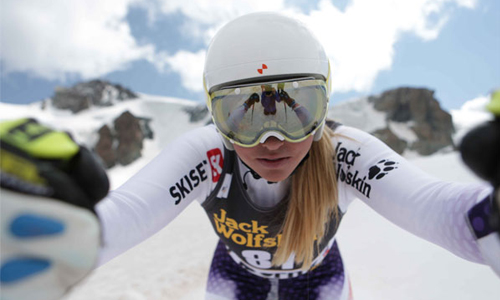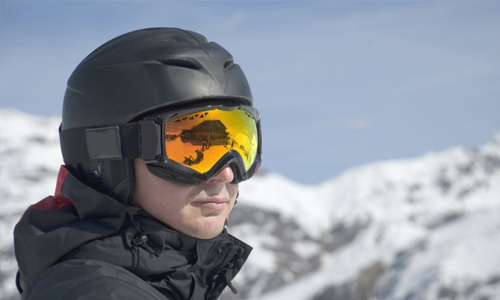The History of the Ski Helmet
Author

Chris shares his passion for cycling, hiking, skiing, and climbing from Buxton, in the Peak District. As a blogger for Outdoor Look, Chris shares outdoor tips and indoor tricks to help you get the most out of your time spent outside. When he's not out adventuring he's making videos or trying to keep up with his 4-year-old son.
 The use of helmets in the sport of skiing has impacted the number of unusual deaths. With a never ending debate on the same along with conflicting views, the importance of Helmets to avoid fatal head injuries has taken a new turn.
The use of helmets in the sport of skiing has impacted the number of unusual deaths. With a never ending debate on the same along with conflicting views, the importance of Helmets to avoid fatal head injuries has taken a new turn.
Throughout the history of skiing, one can notice that skiers seldom had a helmet on their heads. However, it was only in the 1980s, with the invention of light weight helmets that the need to adorn helmets emerged. Downhill skiers have worn helmets for years now, but slalom racers, giant slalom racers, and freestyle racers have in recent years started to give this small piece of shell an important stature.
It had been reported that between the time periods of 1995-2010, there was an increase in the use of helmets that directly affected the head injuries and death rates statistics. Slowly and steadily it became important, and in fact compulsory to wear ski helmets in any organized ski competition. Many known celebrities supported this move.
Helmets were never a consumer product until the 1990s. Motorsports and cycling required the use of headgear. In the early days a “hairnet” with lightly padded leather straps was used. This wasn’t really an effective invention. Boiled-leather helmets with felt or shearling liners too were used by ice hockey and football players. The motorcyclists chose to wear football helmets.
The origin of ski helmets owes hugely to Sir Hugh Cairns. He emphasized on the fact that the ideal protection of the skull is possible with a liner that reduces deceleration of the skull.
Helmets and Slopes
Downhill skiers never felt the need of wearing helmets as the speed on downward slopes was very slow. However, with the introduction of steel edges and Kandahar binding, the speed touched over 30mph.
World War 2 brought about the invention of fiberglass-reinforced epoxy resins and crushable plastic foams. British and American pilots were the first ones to try these. These were used by skiers soon after, in the 1950s. This technology gained success immensely. All crash protection helmets were based largely on EPS crushable foam with or without a protective shell. This American invention was doing rounds across the globe. The Europeans, however, never really appreciated the efforts. This did not crush the faith of the Americans. Incidents like the head injury of Tommy Corcoran maintained their faith in the Bell Helmet.
 Instances of skiers dying due to head injuries while having worn leather helmets were increasing. Hence, for the Olympics in 1960, hard-shell helmets were made mandatory for all downhill skiers.
Instances of skiers dying due to head injuries while having worn leather helmets were increasing. Hence, for the Olympics in 1960, hard-shell helmets were made mandatory for all downhill skiers.
With a switch to metal skis, skin tight suits, the use of hard-shell helmets became more prevalent. However, the weight of the helmets was causing a huge issue with skiers, many of whom died a catastrophic death.
The SR-1 Helmet
Only after 1973 did Bell bring up a motocross helmet that featured a lighter fiberglass shell. The SR-1 was one such helmet by Bell that, like an original motocross helmet, featured a jaw protector and a large face cutout for better fitting of the goggles.
ABS Helmet
The acrynitrile butadiene Styrene (ABS) is a synthetic rubber. The ABS helmets along with EPS were marketed by European companies for kids.There were innumerable helmet companies that manufactured helmets based on EPS liners. With almost all athletes using helmets, head injuries started to reduce and helmets started making waves in the mainstream. Helmets were considered to be life savers, as not only did they provide security along with improved efficiency, but they were also helpful in preventing scalp lacerations, head-bumps etc.
Trouthead
A helmet that allowed the skier to have improved visibility along with no airstream disruption came into existence around 1972. With Carrera producing 500 units, helmets were engineered keeping in mind the trout-head design.
On a personal level I have always felt that wearing a ski helmet can make skiers invincible. This does not mean that injuries are unavoidable, but a helmet can definitely help create a sense of security. I can never afford to go out without adorning a helmet, especially when I am engaged in a sport like skiing which has numerous risks associated with it. Wearing a helmet has now become more than just a safety measure. People have various options to choose from and can look equally cool while you slaying it downhill this season!
Author

Chris shares his passion for cycling, hiking, skiing, and climbing from Buxton, in the Peak District. As a blogger for Outdoor Look, Chris shares outdoor tips and indoor tricks to help you get the most out of your time spent outside. When he's not out adventuring he's making videos or trying to keep up with his 4-year-old son.
- Speed Up Your Post-Hike Recovery with These 6 Essential Tips
- Cycling through Tranquil Roads and Coastal Views on the Isle of Wight
- The Essential Guide to Hiking Safety: 5 Tips Every Hiker Should Know
- Run Smart, Run Strong: Your Guide to Injury-Free Running
- Embrace Biking: Essential Tips for Beginners
Categories
- Sport (28)
- Product Reviews (3)
- Team Outdoor Look (7)
- Mike Wild (2)
- Mike Payton (2)
- Suse Hammond-Pears (3)
- Snowboarding (12)
- Latest Offers (105)
- Shop Talk (1)
- Competitions (7)
- Walking (413)
- Lifestyle Fashion (8)
- Travel (86)
- Kit Guides (176)
- Workwear Clothing (6)
- Safety Workwear (4)
- Health/Fitness (289)
- Skiing (91)
- Great Outdoors (1316)
- Cycling (92)
- January 2025
- December 2024
- November 2024
- October 2024
- September 2024
- August 2024
- July 2024
- June 2024
- May 2024
- April 2024
- March 2024
- February 2024
- January 2024
- December 2023
- November 2023
- October 2023
- September 2023
- August 2023
- July 2023
- June 2023
- May 2023
- April 2023
- March 2023
- February 2023
- January 2023
- December 2022
- November 2022
- October 2022
- September 2022
- August 2022
- July 2022
- June 2022
- May 2022
- April 2022
- March 2022
- February 2022
- January 2022
- December 2021
- November 2021
- October 2021
- September 2021
- August 2021
- July 2021
- June 2021
- May 2021
- April 2021
- March 2021
- February 2021
- January 2021
- December 2020
- November 2020
- October 2020
- September 2020
- August 2020
- July 2020
- June 2020
- May 2020
- April 2020
- March 2020
- February 2020
- January 2020
- December 2019
- November 2019
- October 2019
- September 2019
- August 2019
- July 2019
- June 2019
- May 2019
- April 2019
- March 2019
- February 2019
- January 2019
- December 2018
- November 2018
- October 2018
- September 2018
- August 2018
- July 2018
- June 2018
- May 2018
- April 2018
- March 2018
- February 2018
- January 2018
- December 2017
- November 2017
- October 2017
- September 2017
- August 2017
- July 2017
- June 2017
- May 2017
- April 2017
- March 2017
- February 2017
- January 2017
- December 2016
- November 2016
- October 2016
- September 2016
- August 2016
- July 2016
- June 2016
- May 2016
- April 2016
- March 2016
- February 2016
- January 2016
- December 2015
- November 2015
- October 2015
- September 2015
- August 2015
- July 2015
- June 2015
- May 2015
- April 2015
- March 2015
- February 2015
- January 2015
- December 2014
- November 2014
- October 2014
- September 2014
- August 2014
- July 2014
- June 2014
- May 2014
- April 2014
- March 2014
- February 2014
- January 2014
- December 2013
- November 2013
- October 2013
- September 2013
- August 2013
- July 2013
- June 2013
- May 2013
- April 2013
- March 2013
- February 2013
- January 2013
- December 2012
- November 2012
- October 2012
- September 2012
- August 2012
- July 2012
- June 2012
- May 2012
- April 2012
- March 2012
- February 2012
- January 2012
- December 2011
- November 2011
- October 2011
- September 2011
- August 2011
- May 2010
- April 2010
- March 2010
- February 2010
- January 2010
- November 2009
- October 2009
- September 2009
Submit a Comment